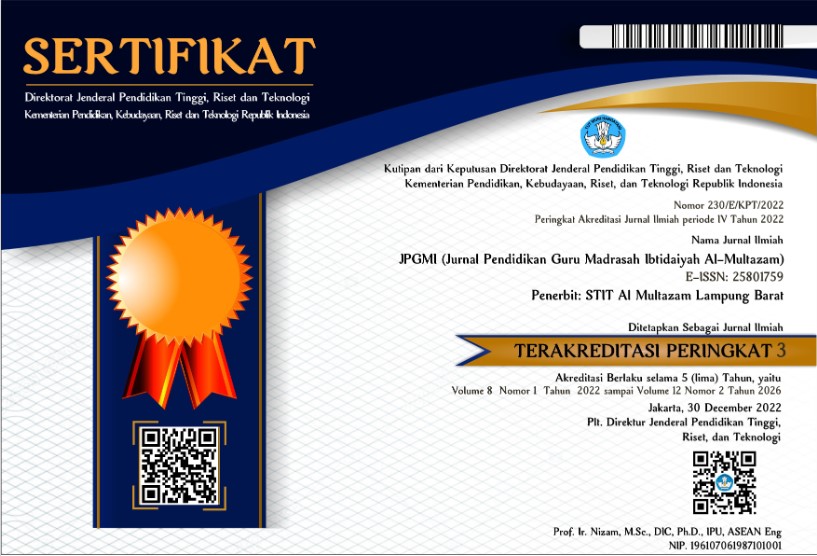MODEL IDENTIFIKASI GAYA BELAJAR SISWA BERKEBUTUHAN KHUSUS PADA SISWA SEKOLAH ALAM PRINGSEWU DENGAN KONSEP SMART LEARNING
(1) Prodi Sistem Informasi, FTIKOM, Institut Bakti Nusantara, Lampung
(2) Prodi Sistem Informasi, FTIKOM, Institut Bakti Nusantara, Lampung
(3) Prodi Sistem Informasi, FTIKOM, Institut Bakti Nusantara, Lampung
 Corresponding Author
Corresponding Author
Abstract
Special Elementary Schools (SDLB), and Integrated Education, specifically for higher education levels, are not yet available. PP No. 17 of 2010 Article 129 paragraph (3) stipulates that students with disabilities consist of students who are: visually impaired; deaf; speech impaired; mentally disabled; quadriplegic; tunable; learning difficulties; slow to learn; Autistic. This research will focus on developing a learning identification model for SLB students with the development of Android-based information technology. To achieve an optimal student learning process, an expert system identification application for learning styles for students with disabilities was designed using an Android-based Expert System with a combination of the Forward Chaining method. The development of learning style identification was carried out at the Pringsewu Natural School using a software prototyping design model with desktop and online concepts. It is hoped that the combination of applications and tools will provide convenience for users, namely schools and teachers. Implementation of an Android-based digital system with a combination of an Expert System with the Forward Chaining Method with software design using Use Case Diagrams. This application will be a medium for measuring learning styles that is more effective and efficient and has high accuracy by testing results using black box testing. The system used to describe the model and flow of this application is Use Case Diagrams, Activity Diagrams, and Class Diagrams and uses a combination of decision trees with the Expert Forward Chaining concept with the Smart Learning concept. From the test results of the application used, the system was declared feasible and good with an accuracy of 97% using it.
Keywords
References
Persiden Republik Indonesia. Undang-Undang Dasar 1945 pasal 31 ayat 1. 1945.
Persiden Republik Indonesia. Undang-Undang Republik Indonesia Nomor 20 Tahun 2003 Sistem Pendidikan Nasional. UU RI No 20 Tahun 2003 Indonesia; 2003 p. 1–26.
Indrijati H. Psikologi Perkembangan dan Pendidikan Anak Usia Dini: Sebuah Bunga Rampai (Edisi Pertama). Jakarta: PT Fajar Interpratama Mandiri; 2017. 1–239 p.
Desiningrum DR. Terapi Senam Otak untuk Menstimulasi Kemampuan Memori Jangka Pendek pada Anak Autis. J Psikol. 2016;43(1):30–41.
Maftuhin M, Fuad AJ. Pembelajaran Pendidikan Agama Islam Pada Anak Berkebutuhan Khusus. J An-Nafs Kaji Penelit Psikol. 2018;3(1):76–90.
Saihu. Komunikasi Pendidik Terhadap Anak Berkebutuhan Khusus Di Sekolah Khusus Asy-Syifa Larangan. Andragogi J Pendidik Islam. 2019;1(3):418–40.
Widiastuti NLGK, Winaya IMA. Prinsip Khusus Dan Jenis Layanan Pendidikan Bagi Anak Tunagrahita. J Santiaji Pendidik. 2019;9(2):116–26.
Cox A, Parsons T, Watkin S, Gallagher A. Supporting the delivery of good maternity care for parents with learning disabilities. Midwifery. 2021;102(February):103073.
Marlim YN, Kurniawan WJ. Perancangan Sistem Pakar untuk Menentukan Kelas pada Anak Berkebutuhan Khusus dengan Metode Fordward Chaining. JOISIE (Journal Inf Syst Informatics Eng. 2018;2(2):7.
Mirza R, Lubis AF, Siagian SF, Simamora SS, Sitohang YJE, Claudia C. Pelatihan Regulasi Emosi Untuk Meningkatkan Subjective Well-Being Pada Penyandang Tunarungu di Kota Binjai. J Ilm Bimbing Konseling Undiksha. 2021;12(1):21–30.
Maulid MI, Arifin T. Pengembangan Sistem Pakar Gaya Belajar Anak Dengan Metode Fuzzy Logic Berbasis Android. In: eProsiding Teknik Informatika (PROTEKTIF …. 2022. p. 11–22.
Aisami RS. Learning Styles and Visual Literacy for Learning and Performance. Procedia - Soc Behav Sci. 2015;176:538–45.
Fish WW. The IEP Meeting: Perceptions of Parents of Students Who Receive Special Education Services. Prev Sch Fail Altern Educ Child Youth. 2008;53(1):8–14.
Chand S, Zhang Y. Learning from machines to close the gap between funding and expenditure in the Australian National Disability Insurance Scheme. Int J Inf Manag Data Insights. 2022;2(1):100077.
Brown M, MacArthur J, Truesdale M, Higgins A. The transition from child to adult health services for young adults with intellectual disabilities: An evaluation of a pilot of an online learning resource for Registered Nurses. Nurse Educ Pract. 2022;64(August):103424.
Putra W. Identifikasi Model Pembelajaran Anak Berkebutuhan Khusus Pada Pendidikan Usia Dini. J PAJAR (Pendidikan dan Pengajaran). 2022;6(2):590.
Putra HPUNHSP. Pengembangan Aplikasi Deteksi Dini Pada Anak Berkebutuhan Khusus Di Sekolah Luar Biasa. Hendra Pradibta, Usman Nurhasan, Hilmy Setya Purnama Putra. 2021;14(1):17–27.
Yulianti WY, Liza Trisnawati, Theresia Manullang. Sistem Pakar Dengan Metode Certainty Factor Dalam Penentuan Gaya Belajar Anak Usia Remaja. Digit Zo J Teknol Inf dan Komun. 2019;10(2):120–30.
Cluley V, Pilnick A, Fyson R. Talking about learning disability: Discursive acts in managing an ideological dilemma. SSM - Qual Res Heal. 2022;2(April):100088.
Garcia MB, Mangaba JB, Tanchoco CC. Virtual Dietitian: A Nutrition Knowledge-Based System Using Forward Chaining Algorithm. In: 2021 International Conference on Innovation and Intelligence for Informatics, Computing, and Technologies, 3ICT 2021. 2021. p. 309–14.
Pramesti AA, Arifudin R, Sugiharti E. Expert System for Determination of Type Lenses Glasses Using Forward Chaining Method. Sci J Informatics. 2016;3(2):177–88.
Article Metrics
Abstract View : 49 times
: 49 times Download : 26 times
Download : 26 times
DOI: 10.54892/jpgmi.v9i2.235
Refbacks
- There are currently no refbacks.


